Devil Take The Hindmost
“Devil Take the Hindmost: A History of Financial Speculation” by Edward Chancellor is a comprehensive examination of the history of financial speculation, exploring its causes, consequences, and enduring impact on economies and societies. Here’s a summary of its key points:
Historical Context: Chancellor begins by tracing the origins of financial speculation, examining its evolution from ancient times to the modern era. He explores how speculation has been intertwined with economic development, innovation, and globalization throughout history.
Speculative Manias: The book delves into various speculative bubbles and manias that have occurred over the centuries, from the Dutch tulip mania of the 17th century to the dot-com bubble of the late 20th century. Chancellor analyzes the psychological, social, and economic factors that contributed to these episodes of irrational exuberance and subsequent busts.
Financial Innovation: Chancellor explores the role of financial innovation in fueling speculative excesses. He discusses how innovations such as stock markets, futures markets, options trading, and complex financial instruments have both facilitated economic growth and paved the way for speculative excesses and financial crises.
Regulation and Governance: The book examines the role of regulation and governance in managing financial speculation. Chancellor discusses the historical development of financial regulation and explores the successes and failures of regulatory efforts to curb excessive speculation and protect investors.
Investment Strategies: Chancellor analyzes various investment strategies and approaches to navigating speculative markets. He discusses the pitfalls of following herd behavior, the importance of risk management, and the challenges of timing market cycles.
Market Psychology: The book delves into the psychology of speculation, exploring the emotions and cognitive biases that drive investor behavior. Chancellor discusses how fear, greed, overconfidence, and herd mentality can lead to irrational decision-making and contribute to speculative bubbles and crashes.
Lessons Learned: Chancellor concludes by drawing lessons from history that are relevant for investors, policymakers, and society as a whole. He emphasizes the importance of understanding the dynamics of speculation, exercising caution in times of exuberance, and maintaining a long-term perspective in investing.
Overall, “Devil Take the Hindmost” provides a fascinating and insightful exploration of the history of financial speculation. Through historical analysis, Chancellor sheds light on the recurring patterns and dynamics of speculation, offering valuable insights into its causes, consequences, and implications for the future.

